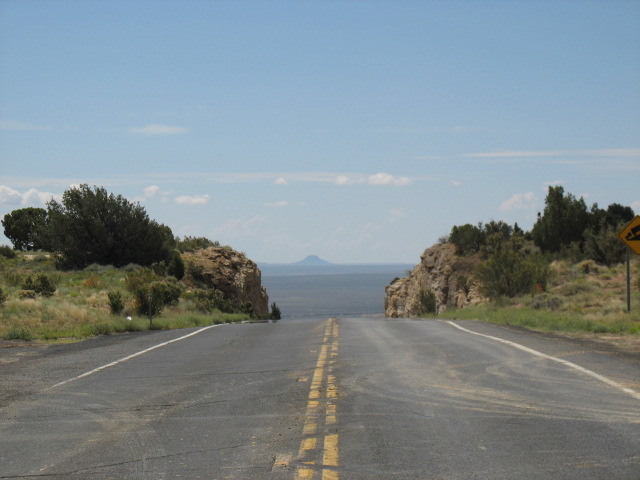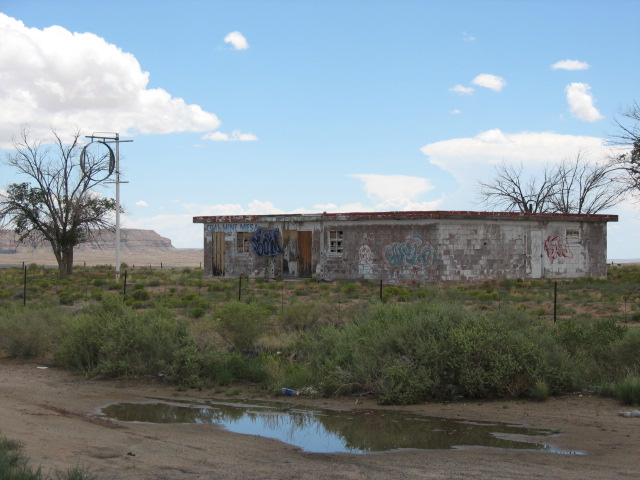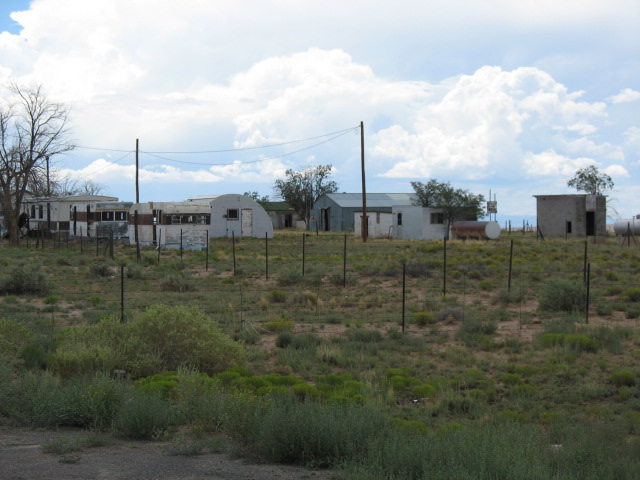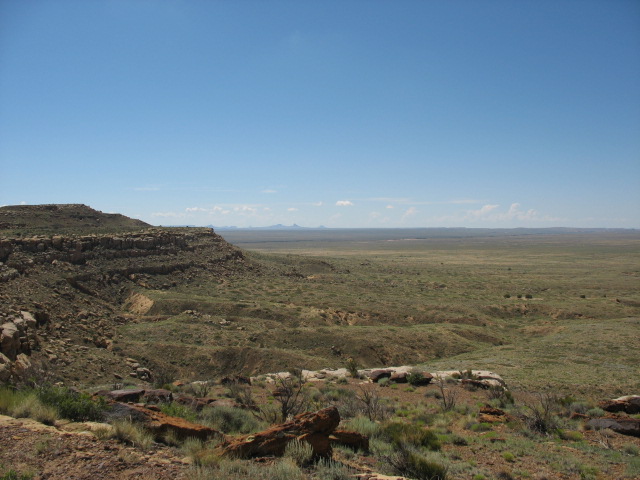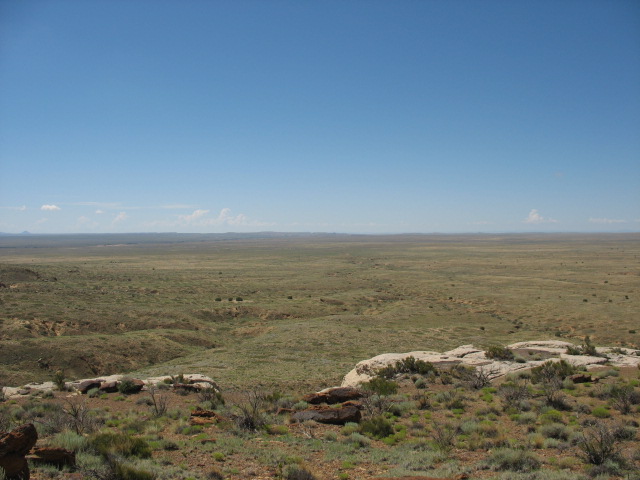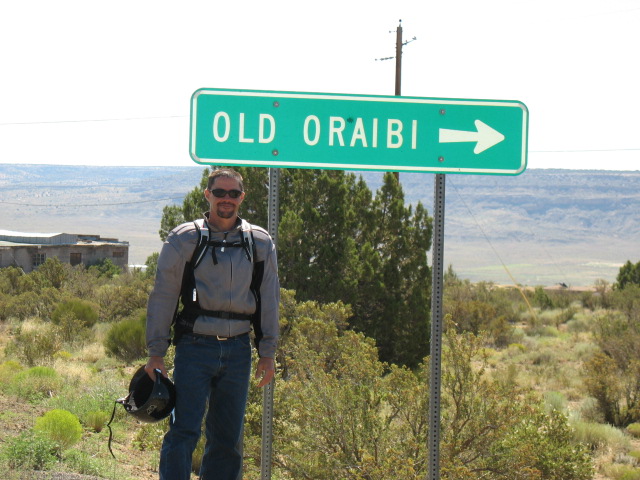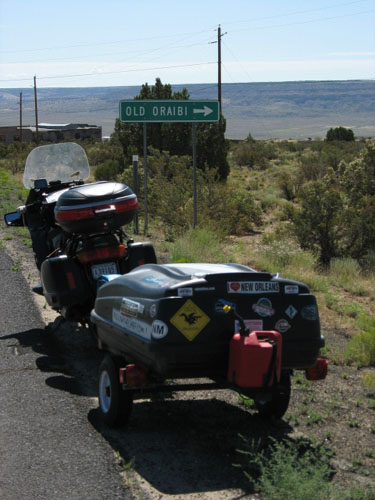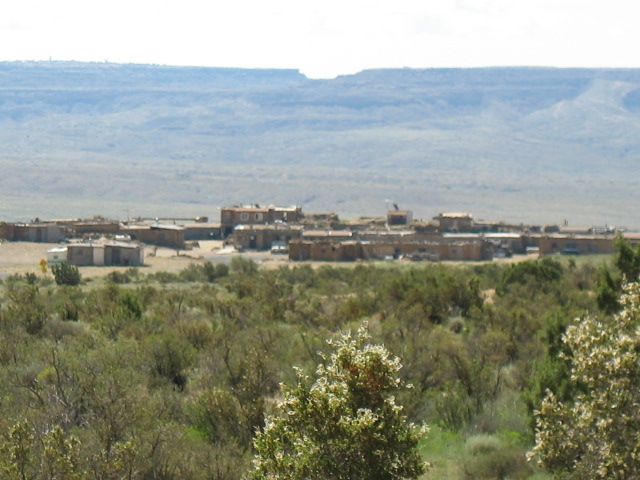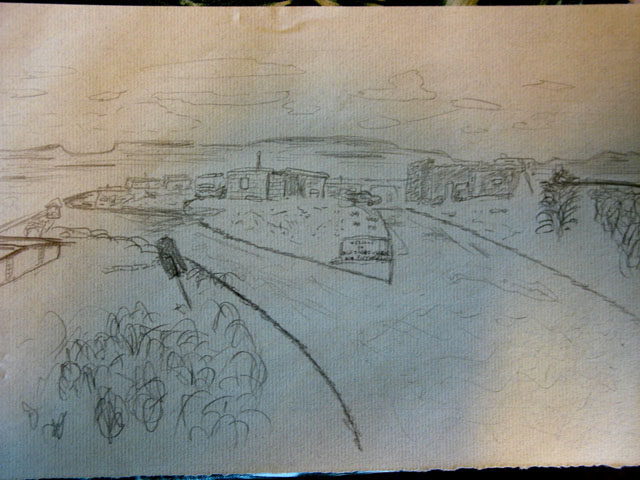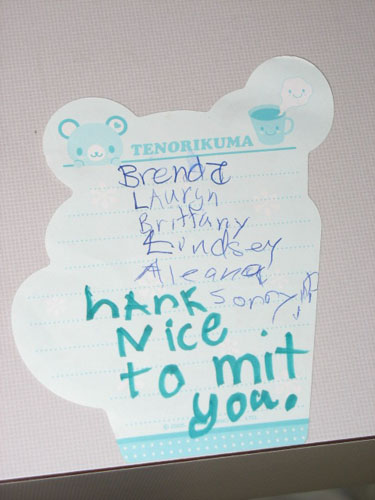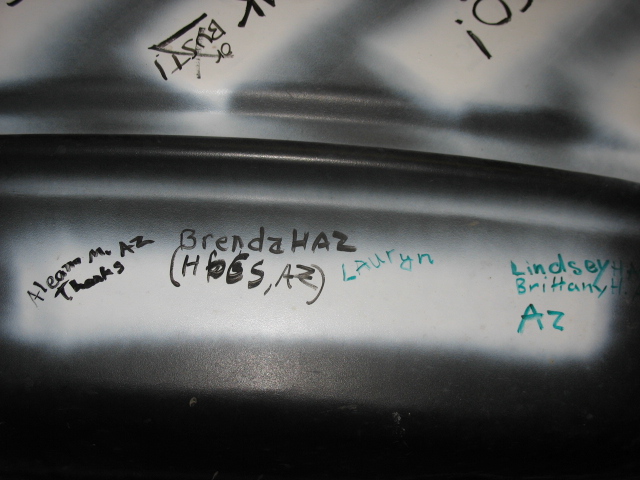| Day 27 (Aug. 7th): TUBA CITY to GRAND CANYON NAT'L. PK. (North Rim Campground), AZ | 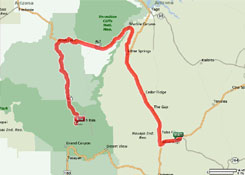 |
| <- PREVIOUS DAY | Predicted Dist. & Time: 160 mi. / 3:15 - Actual Dist. / Drive / Total Time: 249.1 mi. / 5:03 / 8:07 | On to Page Two -> | |
|
Click n' Return:
|
DAY TWENTY-SEVEN COMMENTARY (Page One) I was up with the sun -- which is to say, at about 6:30 AM -- yet I still somehow didn’t leave camp until more like 9 AM. Or possibly 10 AM, depending on who you ax. Even after a few days, I still cannot really make up my mind what time it is, since the state of Arizona does not recognize daylight saving time, while Navajo Nation does, and meanwhile as I think I’ve mentioned, my cell phone will automatically change the time it displays depending on which state it is pulling a signal from. Got all that? Maybe the ants know what time it is, though I haven’t seen even one of them since I cleared them out yestiddy. On the other hand, there are these two pretty mean lookin’ crows perched on a tree branch directly above the tent; if they start bombing me, they are in for a world of hurt, to be delivered by whatever weapons I can lay my hands on. ITEM: I have decided that I will visit Old Oraibi after all, and subsequently will try to find the Hopi Indian gentleman who my hostess, from two weeks and 2,300 riding miles ago in Fredericksburg, TX, told me about. It’ll be fully one hundred miles and probably three hours directly in the opposite direction of travel for today. But I thought about it, perhaps while I slept, perhaps this morning, I don’t really know when, and bottom line is this: after all this time, and distance, and experience, and, like, life, how could I not try to find this dude? Consider: on July 13th, completely at random in the lobby bar of the Knoxville (TN) Crowne Plaza -- 1,700 miles as the crow flies from where my sorry arse currently finds itself, but some 4,700 miles as The Chief (tm) rides -- a guy I’ve never met, at a bar I shouldn’t have been in, tells me I should check out the oldest continually inhabited village in North America if, y’know, my travels take me this way. Two weeks and 2,200 riding miles after that, in F-Burg, I meet and am welcomed into the home of a woman who knows a Hopi tribal advocate personally, and gives me the low-down on everything. And after all that, this morning I’m only a hundred miles away. To not go, now? What am I doing out here, then? It is an absolutely beautiful day for motorcycle riding: sunny and bright, yet not very hot, and with a light breeze making itself recognized almost exactly when one wishes for it. The road out of Tuba City climbs, it dips; it cuts through ridges, it curves over dry washes, it passes by the abandoned Coal Mine Mesa settlement (click to read a very detailed account of the political forces which have carved up this entire area, and created tensions between the previously amenable Navajo and Hopi people some 150 years ago). Finally the road climbs a bit and stays up there, and this is the Black Mesa on the side away from the coal mine I saw yesterday, presiding in its natural state over the grasslands below. Upon Black Mesa there are further divisions referred to as First Mesa, Second Mesa, and Third Mesa. From the direction I was coming, Third Mesa appears first, and this is where the town of Old Oraibi is found. I posed for a picture in front of the sign announcing the gravel road turn-off, and took a shot of the town from afar. This is as close as I wanted to get whilst swinging a camera around, as I had already learned that the Hopi do not prefer to have their photographs taken. In fact, such a request appears on the wooden sign down near the beginning of the town area -- “No Pictures Please”. Needless to say, I wasn’t about to ignore that directive, so when I got down there, I thought, you know, why not sketch the town instead? Wouldn’t that be just about the most elegant way to do it -- to directly record what it is that I saw, and felt, with my own hands? The cleanest sheets of paper I had were a textured ivory selection, better for resume printing than for sketching, and the only pencil I had was the one that I believe may have already been in one of the storage pockets of the bike when I bought it four years ago. All it does is to write down odometer readings after refuelings, and it has no eraser, and I’m sure I’ve never sharpened it…yet here it was, being pressed into service for merely the most important ninety minutes of its life. And there I was -- leaning on the tailbag of the bike, still fully dressed, out in the sun, sketching, trying to blur with my fingertips, taking note of the two or three cars and one sightseeing van that passed by. Couldn’t care less if they were going in there and breaking the main rule -- I was doing it right. So despite the fact that neither the paper nor the pencil were terribly good for either the sketching or for displaying digitally, I am very happy with the way it turned out, and if you want to see it in person you must travel to Surfside Beach, SC, where it now resides. After packing up, um, all of my art supplies and getting back to the main road, I was about to turn right (east) to head to the village of Kykotsmovi, where I thought I recalled being told that my Hopi fellow lived (and while we’re at it, let’s henceforth refer to him as “CJ”). Just before I did, something made me realize he was in the village of Hotevilla instead, back towards the west, in the direction I’d eventually go to continue my journey for the day. I took the turn-off and passed only a handful of houses; I was wondering what my play would be, whether to see if I could see anyone in any of them, or maybe to knock on a door, or who knows what, but soon enough I saw the local grocery so I pulled over and went in. The place was pretty big and looked like it had some interesting food, not to mention that it was probably the public social gathering-type place for the village. I was the only one in there and I wasn’t terribly upset to conclude that I was probably being given the once-over by the proprietress, who was likely skeptical of most gringos who strolled in here -- not to mention ones decked out in motorcycling togs -- and probably had every right to be. But here was the thing: I probably wasn’t going to get anywhere if I couldn’t get any answers from anyone, so I asked her plain and simple if she could tell me where CJ lived, and I explained that I was directed to him by a personal and spiritual friend of his from back in Texas. Let’s face it: it was all completely the truth, and I couldn’t have delivered it any differently if I had tried. Well, after a few seconds I suppose, she started to speak, and she had apparently decided to tell me where he lived. I was not to receive any street name or number -- perhaps these don’t really exist in villages like this? -- but she was outlining it with a pen on the countertop. She told me to go past a few kavis and then bear right at the fork. The directions were fine in and of themselves, but I had to sheepishly ask what a “kavi” was, because it sounded important. And she told me that they were the stone homes built into the ground, so that they were partly subterranean. We then realized that she had just drawn, in ink, all over her countertop! Fortunately she wasn’t too worried about that. Having gotten the info I needed, I had to take care of one other thing, so I asked if the hot pickles were good -- because they sure looked like they were -- and after a response in the affirmative, one of them found itself along for the ride. Making a right and heading deeper into the village, away from the main road, the surface turned to dirt, and then became somewhat sandy to boot -- not easy to handle. On my left, there were three young boys, perhaps between the ages of three and six, not wearing a stitch of clothing, bathing in a pool of water collected in a pit in the ground in front of their little house. I came to the kavis and made a left as directed; paddling the rig around in the sand, I was no longer recognizing anything that the lady at the grocery store had included in her directions. Radiator cooling fan blowing constantly now on the bike, not making much progress, looked like it was going to be door-to-door time, though at least I was closer now than I was before. Then I saw a few younger guys working on a roof nearby, so I let the bike slide itself in their general direction and asked if they knew my man. The first gentleman off the ladder said he did, and that he would walk me over just a couple dozen yards away behind us. This was very thoughtful, except that I couldn’t turn the rig around in the sand, so instead I went “around the block” again and came to the house to which I was being led. I tried to park as non-threateningly close to the front door as I could -- without dropping the sidestand into a pile of sand and sending the whole thing crashing to the ground, that is. A man in his mid- to late-forties emerged from the house and began to approach me. Fortunately I had time to remove my helmet, gloves and earplugs before he got to me, to look at least a little more human, and I asked if he was, y'know, my man. Even now, after all this, I was not really prepared when he said that he was. People! After weeks and weeks, and across thousands of miles, I HAD FOUND CJ. I introduced myself and said that we had never met nor spoken, but that I had been directed to seek him out by a now-mutual friend back in Fredericksburg. Trying desperately not to sound, um, desperate, I dropped my last few remaining keywords to legitimize my contact back in the Lone Star State...and I was invited in to his home. The family was there, and the family pooch, and there were some wonderful aromas coming from the kitchen. Conversation seemed slow, but I realize it was just my perception of it -- I was nervous, as I felt I was imposing on his time. I know it would be popular to say that I am fond of talking, and I could not reasonably disagree with such an observation, but it is also true that I am inquisitive about things I know little about, and in the end typically ask just as many questions as I answer. Well, in all seriousness, I somehow managed to ask him almost no questions whatsoever; for instance, what was his role there? Why and how did he and the Texas lass come to meet? How did she help him, and vice-versa? No, I allowed my nervousness to preclude asking any of this, and now I have literally come away from an almost transcendental meeting knowing almost nothing further about the man, at least, nothing in his own words, of his own telling. What a jackass, huh? OK, so, as bad as all this was, I tried to salvage the situation by buying some of the food that was being prepared, destined as it was for the upcoming village food festival. Here, too, I apparently couldn't be bothered to find out what that was all about either -- its purpose, frequency, etc. Therefore, I again came away from a chance meeting with a gentleman of a wholly different culture, and life, with little to no understanding of what made it different. A rare miss, and non-follow-through, by The Chief (tm), and a most regrettable one at that, I am forced to admit. Little could I guess that I was about to become immersed with people of the Hopi nation on the much more personal level I had originally hoped for, as innocuous as the start of the episode was. Returning to the main part of the village, I carefully picked my way between the sand and humps in the road -- noting that the boys in the "pool" in front of their kavi had apparently gone inside -- and stopped at the tiny little Post Office to mail the Oraibi sketch back east. Upon exiting the shed/building, I found myself blocking the path of five schoolgirls, perhaps between the ages of nine and twelve, on their way back home. Something about my appearance -- the mesh jacket, the boots, the hydration pack...or perhaps simply my non-Native skin coloring -- got their attention, and I was soon at the center of a barrage of youthful, yet well-thought out questions. For instance, regarding when I was out on the road on the bike, one of them wanted to know what happened if I felt hot (I drank some water from the hydration pack). What if I “had to go to the bathroom”? Tougher one, but the answer I gave was, “the same as what happens when someone is in a car!” (WOW -- talk about an excellent non-answer! Mebbe I should become a politician.) Talk turned to school, to the ice cream pop that one of them was eating (making her lips and fingers -- and everything she touched -- bright red), and so on. When it became known that I had grown up in New York, one of them leaned in close and said -- not so much asking but stating, in hushed, somber tones -- “you can't see the stars in New York.” I had to tell them they were pretty much right on that one, or at least you certainly couldn't see as many stars as I imagine they could out here. It was a real riot, as you could see their different personalities manifesting themselves over the course of the conversation. Eventually they went to leave, but when they got about fifty feet away they asked my name, and wondered how they could remember it. I jokingly explained about the idea of signing someone's cast when they broke an arm or something. Well, they were all silent for a few seconds, looking at each other, and then they came marching back over to where I was standing. I looked at them, my body language trying to ask what was up, when the “leader” of the group -- or, at least, the oldest and/or most mature -- stuck her arm out in preparation for me to sign it. I cracked up! I had to tell them I couldn't do that because their mothers would kill me! The youngest one asked if they could write me a note, and of course I said sure, so she took a sheet from a notepad and they all signed it for me. But then I thought of something else I thought they'd love -- even though it would do nothing to help them remember my own name. Since I had previously painted those white stripes onto the trailer in preparation for writing new destinations onto them (see Day Twenty-Five ), and a few hadn't been used yet, I told them they could all sign their names into one of the blank spaces. Thrilled to do so, they took turns, using the only two colored dry markers that hadn't already fallen off of my tank bag, somewhere back across this great country of ours I sensed that our meeting was nearly over, but for a moment it was rescued, as their teacher came walking by and we all chatted briefly. It was then that I realized how great it would be to get a picture of the girls posing near the trailer they had just signed, especially as a balance to the shot of the two brothers back in Sanderson, TX. The problem with this, of which I was already aware: the Hopi, remember, do not care to have their picture taken. Now, having just spent an hour as an ambassador for the outside culture, and exchanging reassuring pleasantries with each adult who passed by, I thought I might have had a shot at avoiding the “ugly American” tag -- even had I asked the teacher if one little picture was OK to capture the moment for the website. In the end, though, I decided that as a mark of respect, I wouldn't even ask, and I didn't. As such, you will have to interpret what you will from this charming picture. Can you believe that one of them wrote “Thanks”, to me? Ladies, the "thanks" for an uber-pleasant hour were utterly, completely, and unforgettably mine. On to Page Two |
||
|
|
|||
